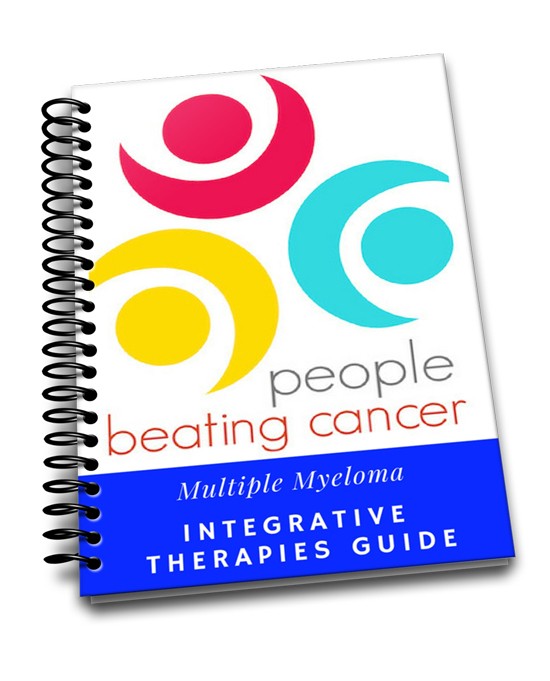Leave a Comment:
1 comment
[…] Evidence-based Therapies for Extramedullary Myeloma […]
Reply
Multiple Myeloma an incurable disease, but I have spent the last 25 years in remission using a blend of conventional oncology and evidence-based nutrition, supplementation, and lifestyle therapies from peer-reviewed studies that your oncologist probably hasn't told you about.
Click the orange button to the right to learn more about what you can start doing today.

According to the article linked and excerpted below,”extramedullary multiple myeloma is the clonal plasma cell spread to tissues outside of bone marrow.” To put this in layman’s terms, when MM spreads outside of the bone it forms extramedullary tumors.
A MM specialist is quoted in the article below by saying that extramedullary disease can happen after a person relapses 7 or 8 times. The challenge is that extra medullary MM present their own issues separate from the average MM lesion.
To learn more about evidence-based, non-conventional, non-toxic therapies, managing and alleviating side effects, and overall structuring your life to support your body and fight Multiple Myeloma, please watch the video below:
To Learn More About Extramedullary Myeloma- click now
Please scroll down the page, post a question or comment if you would like to ask me a question.
Thank you,
David Emerson
“Purpose of review: Extramedullary disease (EMD) is a rare but recognized manifestation of multiple myeloma (MM), characterized by involvement of several organs including skin, liver, lymphatic system, pleura, and central nervous system. The incidence is about 3-5% in newly diagnosed MM patients, but has been reported in up to 20% patients in the relapsed MM setting.
Recent findings: Presence of EMD has been associated with more aggressive phenotype of MM, elevated serum lactate dehydrogenase (LDH) enzyme, and high-risk cytogenetics [deletion 17p, translocation (4;14), translocation (14;16)].
There are several hypotheses of how EMD occurs, including factors leading to bone marrow emancipation and hematogenous spread. The treatment schema usually follows that of high-risk MM. The current review summarizes the disease characterization data, along with available data on clinical activity of available anti-MM agents for this entity.
“Extramedullary dissemination of multiple myeloma portends more aggressive disease but no predictive circulating biomarkers for this condition are yet available and the molecular mechanisms involved in extramedullary progression are still being learned…
“Extramedullary MM is the clonal plasma cell spread to tissues outside of bone marrow; it is present at the time of diagnosis in 7% to 20% of patients and occurs with disease progression and relapse...
Is not uncommon for patients to have other features of advancing myeloma including renal failure or hypercalcemia,” Dr Fonseca explained. “Most patients that present with extramedullary disease will need aggressive treatment.”
Physicians need to be aware that these can be confused with other tumors, Dr Fonseca said. “These clinical presentations are atypical for what we normally think about MM.”
If the disease is able to grow outside the regular niche (the bone marrow), that is a sign that the tumor cells have a more aggressive biology and the disease is more resistant to conventional therapy,” he explained. “Therapy may result in a response, but on average, the disease is more likely to relapse again. Systemic therapy is used to treat a patient with bone marrow involvement and additional extramedullary disease.”
“The current study assesses the characteristics and outcomes of multiple myeloma (MM) patients, treated with novel agents for hematogenous extramedullary (HEMM) relapse. Consecutive patients diagnosed with HEMM between 2010-2018 were included. Patients’ characteristics at diagnosis and at HEMM presentation, response to treatment, survival and factors predicting survival were recorded and analyzed.
A group of 127 patients, all diagnosed with HEMM by imaging (87.3%) and/or biopsy (79%), were included. Of those, 44% were initially diagnosed with ISS3, 57% presented with plasmacytomas, and 30% had high-risk cytogenetics. Median time to HEMM was 32 months.
In multivariate analysis, ISS3 and bone plasmacytoma predicted shorter time to HEMM (P = .005 and P = .008, respectively). Upfront autograft was associated with longer time to HEMM (P = .002). At HEMM, 32% of patients had no BM plasmacytosis, 20% had non-secretory disease and 43% had light-chain disease. Multiple HEMM sites were reported in 52% of patients, mostly involving soft tissue, skin (29%), and pleura/lung (25%).
First treatment for HEMM included proteasome inhibitors (50%), immunomodulatory drugs (IMiDs) (39%), monoclonal antibodies (10%), and chemotherapy (53%). Overall response rate (ORR) was 57%. IMiDs were associated with higher ORR (HR 2.2, 95% CI 1.02-4.7, P = .04). Median survival from HEMM was 6 months (CI 95% 4.8-7.2). Failure to achieve ≥VGPR was the only significant factor for worse OS in multivariate analyses (HR = 9.87, CI 95% 2.35 – 39, P = .001). In conclusion, HEMM occurs within 3 years of initial myeloma diagnosis and is associated with dismal outcome. The IMiDs might provide a higher response rate, and achievement of ≥VGPR predicts longer survival.”
[…] Evidence-based Therapies for Extramedullary Myeloma […]
Reply